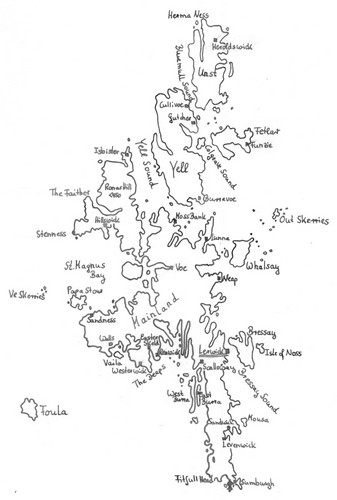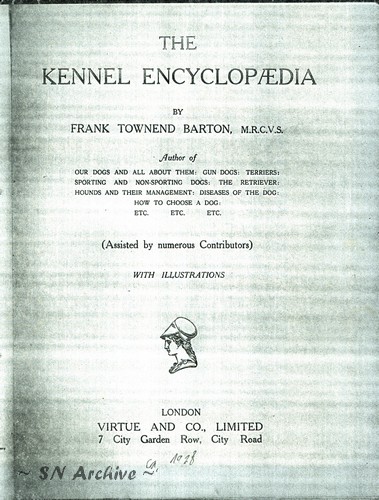 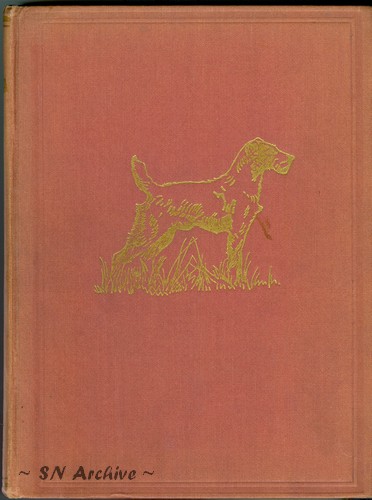 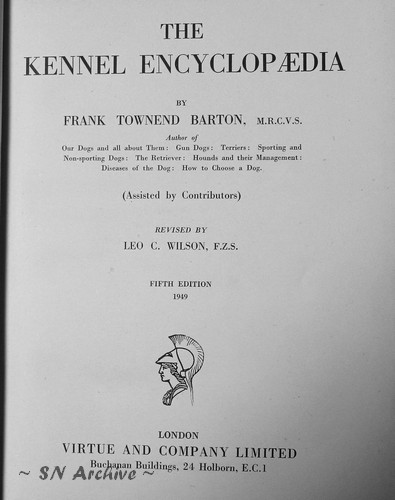 |
The Kennel Encyclopaedia Frank Townend Barton, M.R.C.V.S., Virtue And Co. Ltd., GB, about 1928, *1 The Kennel Encyclopaedia Frank Townend Barton, M.R.C.V.S., revised by Leo C. Wilson, F.Z.S., Virtue And Company Ltd., GB, 5th edition, 1949 |
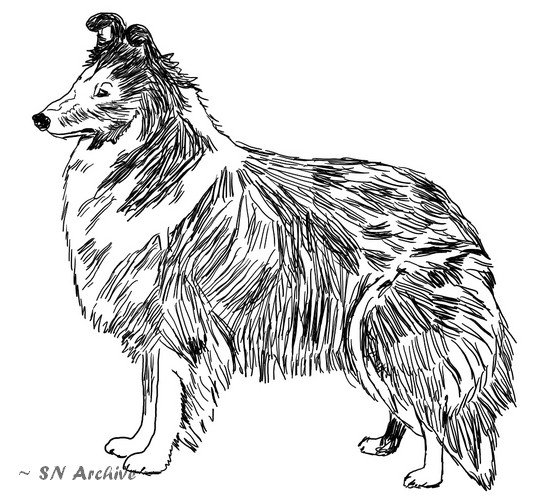 I have two editions of this work. Both differ, due to the year of publication, only in a few sentences. Mr. Barton does not write very enthusiastically about the Sheltie and does not predict a great future for it in the first edition. There is a foto of the sable bitch Ch. Eltham Park Elda (Fall photo) in the later book.
I have two editions of this work. Both differ, due to the year of publication, only in a few sentences. Mr. Barton does not write very enthusiastically about the Sheltie and does not predict a great future for it in the first edition. There is a foto of the sable bitch Ch. Eltham Park Elda (Fall photo) in the later book.
Page 313-314 SHE: "Sheep-Dog, Shetland, The. - This variety of sheep-dog has only been brought into prominence during the last thirteen or fourteen years, although small sheep-dogs have been used by the crofters in the Shetland Isles for generations in connection with rounding up cattle, sheep, and ponies. When these small dogs were shown in England for the first time it was at the Crystal Palace (1909). The exhibits consisted of a most heterogeneous collection of what really ought to be described as 'degenerates' of the prototype, i.e., the collie. The judge looked at the dogs and the dogs looked at the judge, both of whom were equally surprised. However, the judge worked on whatever points he could find, which most nearly approached the collie, and made his award accordingly, thus creating a workable precedent.
Since the time referred to, the breed - if such it ought to be called - has taken on settled characters, and is now forging 'ahead', but that it will ever become very popular the author does not for a moment believe. One would hardly have thought that in such a short period the Shetland sheep-dog would have a monograph, which no doubt has done something for the good of these 'little besties.' The title of the work referred to is 'The Shetland Sheep-Dog', by Beryl Thynne.
There can be no two opinions as to how these dogs came into being, namely, from inferior sheep-dogs brought on to the islands from the mainland, their diminutive size being due to the same factors which have produced the Shetland ponies, viz., food and climatic causes. If really high-class collies had been kept and bred on the islands there is every reason to believe that we should have had a very much better type of the bantamised edition of the collie from the commencement. It takes years to eliminate so many faults from a breed and substitute classical features. We now refer, of course, to conformation only and not just working capabilities - the latter being wonderfully developed in some sheep-dogs which have no pretensions to blue blood.
We may take it that the Shetland sheep-dog's ancestors were 'degenerate' collies and that, although called sheep-dogs, they are with equal proprietary entitled to be called Shetland collies. The term sheep-dog is, however, by far the best title that could have been chosen. Doubtless the yakki dogs, brought over by whaling vessels from Greeland, were occasionally mated with the bitches on the islands, so it is quite possible that there is a dash of this breed somewhere in them.
The term 'toonie dog' is derived from the nature of the dog's work, which is, in addition to what thas already been stated, that of driving the sheep from the toon or town to their grazing grounds.
It was not until 1909 that the Kennel Club recognized the Shetland sheep-dog. A year before this the Shetland Sheep-Dog Club was formed, and in 1909 the Scottish Shetland Sheep-Dog Club was also launched, and were accepted by the Kennel Club for recognition.
In both, the standard of points has been practically the same; but there has always been a difference in weight, the standard for the first named being 14 lbs. and the latter 12 lbs. In both clubs the height is 12 in. as measured at shoulder.
Height and weight count greatly as a matter of course, because it is in these two particulars that the kernel of the breed rests. It would be quite an easy matter to engraft true collie characters into these dogs were it not that height and weight must be preserved at all cost. Naturally the foregoing clubs have done a great deal of good for Shetland sheep-dogs, and will, we hope, continue to do so.
Concerning the general features of these dogs, we may say that they are hardy, intelligent, and docile. They are not, as a rule, prolific, the dam having two or three pups a litter. No doubt prolificacy would increase, especially amongst Shetland sheep-dogs bred and kept in southern kennels. On colour they correspond to that of the collie, so that we often find them as a dark or light sable, sable and white, white, black and tan, black, white and tan, etc. but brindle is not permissible. Conformation should correspond to that of the collie, and the coat likewise should be double, quality of this coat being an important feature amongst all sheep-dogs. Smooth-coated dogs are barred. Such common faults as large drooping ears, light eyes, domed skull, crooked limbs, tail curled over the back, etc., occur frequently, and constitute faults. There are quite a number of breeders of Shetland sheep-dogs in various parts of the country, and dogs are frequently offered for sale in the various weekly journals devoted to dogs. They are not expensive to purchase and as previously stated, there is no particular difficulty in connection with rearing them.
The Shetland Sheep-Dog Clubs have published their standards of points, and these can be obtained on application to their respective secretaries, the addresses of which, if not available, can easily be obtained by application to the Secretary of the Kennel Club, 87 Piccadilly, London. (See Collies.)."
Page 320-322 SHE: "Sheep-dog, Shetland, The. - This variety of Sheep-dog has only been brought into prominence during the last forty or fifty years, ... When these small dogs were shown in England for the first time it was at the Kennel Club Show, held at the Crystal Palace (1909). ...
Since the time referred to, the breed has taken on settled characters, and is now forging ahead and the type is well fixed. There is still some divergence of opinion as to whether the Sheltie should be exactly collie-like in minature or have slight variations - particularly in head - but the difference of opinion is only a minor one. ...
... In colour they correspond to that of the collie, so that we often find them as a dark or light sable, sable and white, white, black and tan, black, white and tan, and, of course, blue merle. ... "
If you discover any errors in the text that may have been caused by the transcription, please let us know for a prompt correction.
*1 Original in Eva-Maria Krämer Collection

